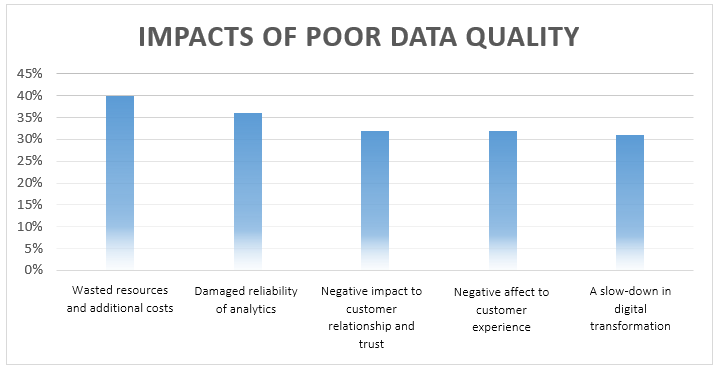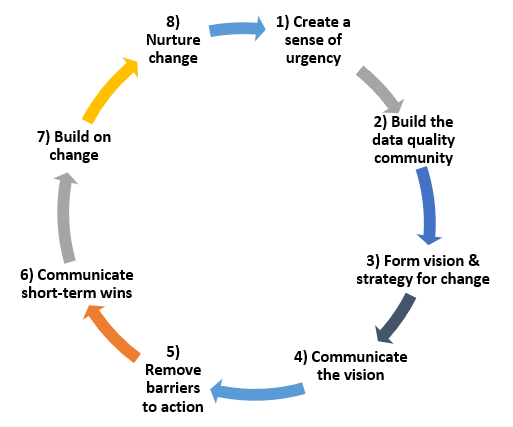Data quality-issues are increasingly seen as a problem concerning whole organizations, not just their IT departments. This article explains how you can improve data quality in eight steps and make the change stick through initiating cultural change.
Creating a Culture of Data Quality within Your Organization
Data is often praised as to be the strategic resource of the 21st century. Thus, collecting data is seen as a necessity when trying to keep up with competition. However, not all data is created equal. Data quality-issues might arise from numerous sources which all leave you with a similar result: data unfit to be used as the strategic resource you want and need it to be.
Even though these data quality problems manifest in technical issues, the root causes often lay in the actions of individual employees as figure 1 shows. A Report by 451 Research wherein 200 Tech executives were asked to name sources of data quality issues within their organization found Data entry by employees (57.5%), Data entry by customers (38.0%) and data migration or conversion projects (47.0%) to be some of the most common causes of said issues. Accordingly, we see a trend in the market in trying to tackle these issues on an organizational level.

While in the past, data quality issues have been addressed mostly in the context of a concrete problem within a project or one database, organizations now are becoming increasingly aware of the long-term effects of bad data-quality, as figure 2 shows. Wasted resources and additional cost is the most pressing impact, with a damaged reliability for analytics and a negative impact on the customer relationship close behind.

To address organization-wide data quality issues, we at CAMELOT suggests a holistic solution, rather than fixing said issues in a patchwork manner that entails multiple technical initiatives to fix individual systems. The most sustainable way to improve data quality is to bring cultural change to the organization which produces these issues organically.
Improving Your Data Quality through Initiating Cultural Change towards a Culture of Data Quality
The following strategy is based on Kotter’s 1996 model on cultural change.

Step 1: Create a sense of urgency
The easiest way of creating a sense of urgency within your organization is to use your most commonly used communication channels for storytelling. In fact, the lack of storytelling about data quality might be one of the reasons why you are facing issues in the first place (Thedataliteracyproject.org, 2020).
Have any IT projects within your organization in the last few months succeeded based on at least acceptable data quality? Great, that is your story right there. By telling a story of members of your own organization succeeding because data was fit for the project, you make the story and the topic of data quality more relatable to your employees. The hero’s journey method of storytelling, for instance, gives clear guidance on how to formulate such a story and has proven promising in communicating organizational change (Brendel & Chou, 2016). While telling the story, make sure it is targeted to either the whole organization or a subgroup of employees (Denning, 2006).
Alternatively, you might feel regulatory pressure to act on data quality. If you are part of a financial institution large enough to be subject of BCBS 239, for instance, the story is easily told: your license to operate depends on measuring and improving data quality. In case of an audit, you might fail if the point is not addressed.
Should none of these examples suit your organization, examples from figure 2 might serve as a starting point for communication with your colleagues.
In case you are looking for insights and support: CAMELOT supports business transformations in data projects as well.
Step 2: Build the data quality community
To build a data quality community effectively, first make sure to gain a sponsor for your data quality initiative. Natural allies might include your CIO, the head of your regulatory or corporate finance department as well as the heads of your BI and data science departments.
Securing the support of one or all the above-mentioned functions certainly supports your effort to establish a culture of data quality – yet it is hardly sufficient. To include all stages of the data lifecycle, reach out to more junior staff members who work with data every day and might provide valuable insights on harmful behavior later. If you do not know exactly who these individuals are, a targeted/ technical or an explorative/survey-based approach can be helpful.
In a targeted approach, start by looking at the most prominent data quality issues and trace them back through a data lineage analysis. Within and at the nodes between systems, you will find members of the organization which could tackle data quality issues upstream. In an explorative approach, you could use the non-response bias of your employees to surveys to identify members of your organization most passionate about data quality.
Once you identified members of your data quality community, get the conversation going. Set up the necessary infrastructure in your messaging services, Outlook, and physical or digital meetings.
Step 3: Form a vision and strategy for the change
Studies suggest that especially senior staff members disengage with internal projects after six to twelve months, so make sure your coalition owns your data quality culture initiative directly, rather than trying to make it a top-down change approach.
After having your data quality community in place, get some traction by having them formulate a vision and strategy for the change. Make sure to include all members of the data quality community in the discussion of your vision and strategy.
The inward-facing vision statement should answer at least the following questions:
- What are our aspirations for the new culture in our company?
- How do we want to achieve this goal?
- When do we want to achieve our goal?
Opposed to the internal focus of the vision, the strategy statement should have a market-facing focus:
- What strategic objective does a culture of data quality help to obtain?
- What should the scope of change be?
- What competitive advantage do we hope to gain?
Step 4: Communicate the vision
With a vision and a strategy laid out that is supported by the data quality community, it is time to communicate it to the rest of the organization. This works best if you encourage the people in the data quality community to start taking actions which support your vision directly:
- Include the current state of data quality in decision making about new or existing IT or data initiatives.
- Can efforts to improve data quality help you with other problems you have had? Ask yourself constantly where else higher data quality can add value.
- Set up regular meetings of the coalition. Talk about progress and whether results deviate from your expectations.
- If you have a well-functioning data governance organization, put data quality on the agenda of your Data Governance Council (or similar organ that takes final decisions in matters concerning data).
- If you have a stage & gate process in place to see whether one of your IT projects has reached a certain milestone, define a threshold of data quality as one of these gates.
- Lastly, mention the new data quality initiative in your main corporate communication platforms and communicate smaller milestones in various internal channels as well.
Step 5: Remove barriers to action
When talking about data quality improvement and cultural change, one of the biggest constraints is budgeting. You will find yourself in a position where rare talent will spend time away from their regular line-functions. Make sure that this time is accounted for in budgeting for the project.
Related to budgeting is another topic, namely the efficiency of the change you want to bring. Here it is important to keep your strategy in mind and tackle the right IT-systems within your organization. To help you identify the systems which require the most attention regarding data quality, conduct a multi-nodal data quality analysis. A multi-nodal data quality analysis and data lineage screening (e.g., done by CAMELOT) can help you to identify the most critical systems in your organization in accordance with your overall corporate strategy.
Furthermore, ask yourself whether your human, financial and technical resources are sufficient for the scale of the project. If necessary, revisit your strategy from step 3.
Lastly, open a feedback loop for your data quality community. You can for example install a digital suggestion box, where members of your community can anonymously give feedback. Make sure you demonstrate that you value feedback and what changes you made based on suggestions. If you disregard some opinions, make sure you demonstrate why.
Step 6: Achieve and communicate short-term wins
To tell a convincing story of successful cultural change, keep in mind that you have two distinct audiences: data-savvy employees directly impacted by data quality and those with only indirect touchpoints. The latter group often creates data at source and is therefore not be neglected.
The most convincing argument for more technical-minded people is to show an improvement to data quality. These employees typically know the impact bad data quality can have and might be more impressed with hard facts on data quality improvements.
We therefore suggest creating an accessible data quality dashboard. This should include data quality metadata on the databases you identified as most critical to your corporate strategy. Technical-minded staff members can furthermore use the dashboard to assess IT initiatives based on the data. Quality dashboards from service partners that are ready to implement are a quick way to communicate improving data quality throughout your organization.
When addressing the wider organization, keep to telling a story of success in quarterly or annual meetings, focusing on individual employees and their stories. Make sure these stories include success that was only possible through higher data quality. Highlight the accessibility of your data quality community, making sure that individuals across the organization know the community exists and how they can join.
Step 7: Build on the change
At this point, you have created an effective team driving change, embedded data quality considerations into decision-making processes, laid out a clear strategy and vision and members of the organization can see and feel an improvement in your data quality. Therefore, it is time to extend the scope of your data quality community.
Furthermore, data quality awareness should now be a key part of your IT and data departments. Data quality should have improved and should be portrayed in the above-mentioned data quality dashboard as a decrease in failed records. Revisit failed IT projects to which failed due to poor data quality to see whether they can be relaunched, if they are still valuable to your strategy.
Most importantly, greater data quality fosters greater trust in data. Encourage the usage of such tools that work better with good data quality to get more of your employees involved with data. The best way of making sure more members of your organization care about data quality is to get them working with data in the first place!
Step 8: Nurture change
Finally, you must make sure to reinforce the change you initiated. This is usually achieved best by setting the right incentives for members of the organization who adhere to the new culture.
Make high data quality a factor in your benefit scheme for those employees that can affect it. If the bonuses in your company are tied to reaching certain goals, why not make a 10% improvement of data quality within a system an annual goal for those who can improve it?
Provide training to the members of your organization feeding data into the systems at ingestion point. Raising awareness for the prevention of data quality issues at source will help you prevent data quality issues before they arise.
Next, new hires need to share the culture of the organization. Hire new IT staff who have at least a moderate interest in data quality. Conversely, minimize the influence of employees who resist the change throughout prolonged periods of time.
Establish a central point of contact for employees who face data quality issues. This way, they will notify you about current data quality issues and your data quality culture will be challenged constructively through real problems arising in the organization.
Conclusion
Rome was not build in a day, and neither is data quality. Instead of focusing on rectifying on one data quality problem after the next and revisiting certain databases on a regular basis, focus on addressing data quality issues so that the change is most sustainable: in your organizational culture. The steps detailed in this article provide a guideline on how you could start this change and how you anchor a high data quality mindset in your organization in the long run, allowing you to leverage data as a truly strategic resource and get ahead of your competition.
However, with regards to organizational culture, there is no “one size fits all” solution. Take time to investigate your corporate culture and to create a tailor-made initiative to embed a positive data quality-culture within your organization. Here, a fresh look from the outside as provided by an external project partner can help to quickly get the project off the ground.
We thank Fabian Tyroller for his valuable contribution to this article.

